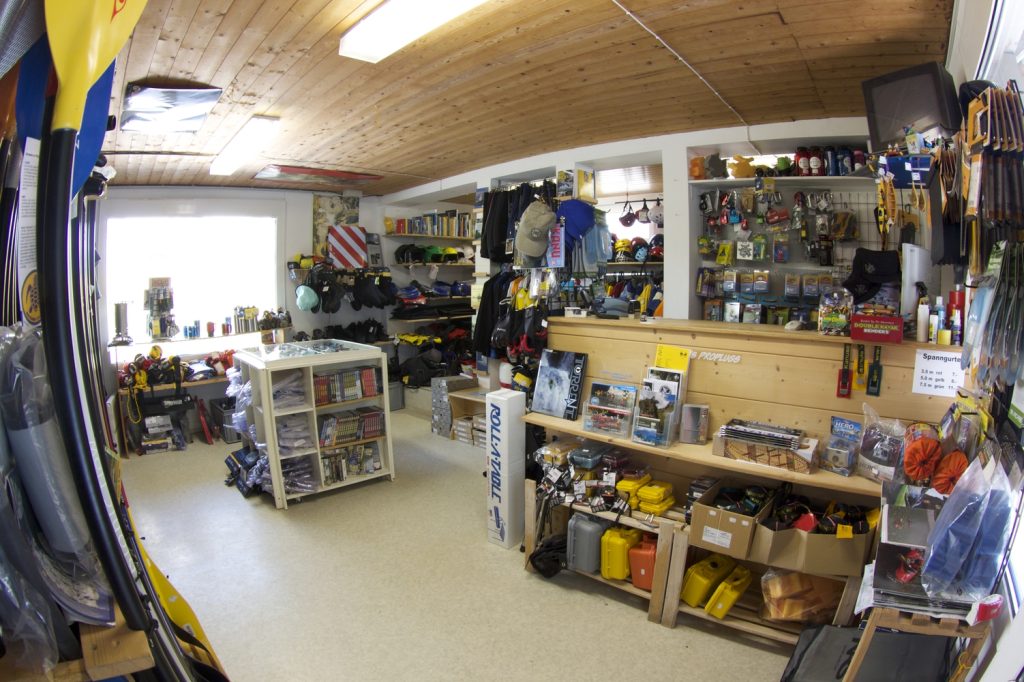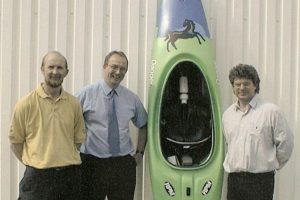Located in the majestic “Swiss Grand Canyon” on the banks of the Upper Rhine River, Kanuschule Versam is a shop, kayak school, and rafting company. Currently celebrating 35 years in business with three passionate Swiss paddling legends behind the wheel – Marcus Keller, Kasi Felman, and Toro Rogenmoser – Kanuschule Versam is a leader on the European paddling scene. We talked to co-owner Toro Rogenmoser to learn more about KSV’s ongoing success.

Thomas Rogenmoser aka Toro. ©Kanu Schule Versam
PGmag: You celebrate 35 years in business this year. Congratulations! How does it feel to have succeeded in your initial dream of making a living from your passion?
Toro Rogenmoser: It feels great. It’s 35 Years for KSV but 25 for me; thanks for reminding me to celebrate!
PGmag: KSV is in Versam, Switzerland, near Ruinaulta on the Rhine River. What drew you to this location?
TR: The founders came here because of a great river, awesome scenery, and the unique opportunity to do train shuttles, which allows kayaking to be less motor-reliant.
“We focus on whitewater kayaking and canoeing. It’s born out of our hobby, and our love for the sport is also the spirit communicated.”
PGmag: We hear the three of you still paddle all year round. Is a passion for paddling the recipe for success?
TR: Yes, we still paddle all year round, but to varying degrees. I think the recipe is to be deeply embedded into what you do: Try to be better at it every day. Know the field, know what’s happening. Being passionate doesn’t mean you HAVE to be on the water all the time. And focus on a specialty. For us, it’s whitewater.

The Vorderrhrine valley also know as the Swiss Grand Canyon ©Kanu Schule Versam
PGmag: Describe the nature of the Kanu Schule (kayak school). What is the spirit your programs aim to develop?
TR: We focus on whitewater kayaking and canoeing. It’s born out of our hobby, and our love for the sport is also the spirit communicated. We try to teach students to be safe, passionate, and caring.
PGmag: What is the rough percentage split between all three activities—kayaking, canoeing, and rafting—in terms of revenue?
TR: Roughly, all three parts are similarly big. The difference lies more in how the revenue relates to other parameters. For example, the shop takes the biggest upfront investment (inventory), and the school needs the most human power, aka teachers. But we look at the overall package, not single numbers.
“Overall, we are back to—quite exactly—pre-Covid, which started with a big spike in online sales during lockdowns, followed by a peak summer for rafting and courses when people could not go abroad.”
PGmag: Why did KSV expand to include a retail shop? Was it a financial necessity or a more service-driven initiative?
TR: The retail store opened in 1994, so that was a bit before my time, but it grew naturally from buying gear for ourselves to having a few items for our customers. It started with a handful of items and slowly grew because it made sense. One constant challenge: our available space seems to grow more slowly than the inventory…
PGmag: Have you seen any lasting changes in interest and business since Covid?
TR: Overall, we are back to—quite exactly—pre-Covid, which started with a big spike in online sales during lockdowns, followed by a peak summer for rafting and courses when people could not go abroad. With the shop, we have to manage a bit of overstock. We also now stock up record-early, an holdover from when we were sold out of many items and manufacturers were, too.

©Kanu Schule Versam
PGmag: How do you approach online sales? Do most customers ship products or pick up their orders at the shop?
TR: It’s around 50/50 overall. In winter, it shifts to 99% online with shipping. We are basically located on the riverbank of one of the Rhine’s most paddled sections in Switzerland, so we are the drive-in of kayak shops. We even put a plastic floor in the shop because paddlers often come in dripping wet!
PGmag: Who is your clientele? Are the demographics the same for the shop, rafting business, and kayak school?
TR: Overall, we have mostly Swiss clients. Interestingly, this is also true for rafting. Our rafting clients are people of all ages, individuals, companies, and clubs/associations. In the School, we have a gap between the ages for youth camps and when young people can pay for a course themselves. Maybe it’s also the age where one feels most adventurous and ready to learn by trial and error.
“Tradeshows are important. I prefer a long(ish) drive to a show to see everything in one place over reps coming to our place to present new products”.
PGmag: Do any recent innovations excite you?
TR: For me, there’s a stark contrast between the development in boats vs. gear. For boats, there’s the shift in the predominant type/discipline to the current half-slice craze, but also big trends and changes within the disciplines, which really are exciting. But I am disappointed with the development of gear. The dry suit took over, but apart from that, I mainly see fashion-type changes rather than technical improvements. That may help something sell better, but it makes it harder for shops. Slight changes and fancy new names for colors and color schemes make for a lot of unwanted work in inventory and web software. I am more interested in practical features: Saftey/visibility, wet-weight (how heavy am I after a swim?), durability, usability; these innovations may exist but aren’t being promoted as much.
PGmag: We’ve seen you every year at the Paddle Sports Show and for 15 years before that at PaddleExpo. Will we see you again in Strasbourg?
TR: You will. Tradeshows are important. I prefer a long(ish) drive to a show to see everything in one place over reps coming to our place to present new products. I also like the social part of meeting people from the business and people I used to see in eddies. It’s important to us to have one show, and not several different ones. We’re happy that our entire whitewater niche is represented in one show.




